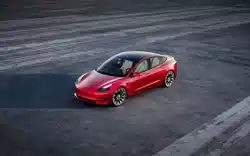Loading ...
Loading ...
Loading ...

Features
These safety features are available on all Model 3
vehicles:
• Lane Assist (see Lane Assist on page 110).
• Collision Avoidance Assist (see Collision Avoidance
Assist on page 113).
• Speed Assist (see Speed Assist on page 116).
•
Auto High Beam (see High Beam Headlights on page
55).
These Autopilot convenience features are designed to
reduce driver workload:
•
Trac-Aware Cruise Control (see Trac-Aware
Cruise Control on page 83)
• Autosteer (see Autosteer on page 88)
•
Auto Lane Change (see Auto Lane Change on page
90)
•
Autopark (see Autopark on page 102)
•
Summon (see Summon on page 104)
•
Smart Summon (Smart Summon on page 107)
•
Navigate on Autopilot (see Navigate on Autopilot on
page 92)
•
Stop Light and Stop Sign Warning (see Stop Light
and Stop Sign Warning on page 91)
•
Trac Light and Stop Sign Control (see Trac Light
and Stop Sign Control on page 95).
NOTE: Depending on market region, vehicle
configuration, options purchased, and software
version, your vehicle may not be equipped with all
Autopilot features.
You can enable/disable some of these features and in
some cases, control how they work. To access settings,
touch Controls > Autopilot.
Drive to Calibrate Cameras
Model 3 must maneuver with a great deal of precision
when Autopilot features are being used. Therefore,
before some features (for example,
Trac-Aware Cruise
Control or Autosteer) can be used for the first time or
after certain Service repairs, the cameras must
complete a self-calibration process. For your
convenience, a progress indicator is displayed on the
touchscreen.
Calibration typically completes after driving 20-25
miles (32-40 km), but the distance varies depending on
road and environmental conditions. Driving on a
straight road with highly-visible lane lines allows Model
3 to calibrate quicker. When calibration is complete, the
Autopilot features are available for use. Contact Tesla
only if your
Model 3 has not completed the calibration
process after driving 100 miles (160 km).
NOTE: If you attempt to use a feature that is not
available until the calibration process is complete, the
feature will not be enabled and the
touchscreen
displays a message.
NOTE: Model 3 must repeat the calibration process if
the cameras are serviced by Tesla, and in some cases,
after a software update.
NOTE: If the cameras have moved out of their
calibrated position (for example, due to a camera or
windshield replacement), the calibration can be cleared
by touching
Controls > Service > Camera Calibration >
Clear Calibration. Once the calibration has been
cleared, the self-driving calibration drive must be
performed again.
Limitations
Many factors can impact the performance of Autopilot
components, causing them to be unable to function as
intended. These include (but are not limited to):
•
Poor visibility (due to heavy rain, snow, fog, etc.).
•
Bright light (due to oncoming headlights, direct
sunlight, etc.).
•
Damage or obstructions caused by mud, ice, snow,
etc.
•
Interference or obstruction by object(s) mounted
onto the vehicle (such as a bike rack).
•
Obstruction caused by applying excessive paint or
adhesive products (such as wraps, stickers, rubber
coating, etc.) onto the vehicle.
•
Narrow or winding roads.
•
A damaged or misaligned bumper.
•
Interference from other equipment that generates
ultrasonic waves.
•
Extremely hot or cold temperatures.
WARNING:
The list above does not represent an
exhaustive list of situations that may interfere
with proper operation of Autopilot components.
Never depend on these components to keep you
safe. It is the driver's responsibility to stay alert,
drive safely, and be in control of the vehicle at all
times.
CAUTION:
If a windshield replacement is needed,
take your vehicle to Tesla Service. This will ensure
appropriate handling and mounting of the
camera(s). Failure to do so can cause one or more
Autopilot features to malfunction.
About Autopilot
81Autopilot
Loading ...
Loading ...
Loading ...
